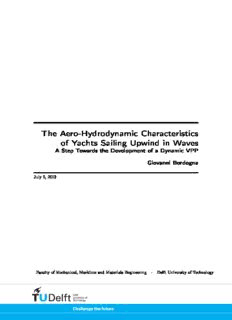
The Aero-Hydrodynamic Characteristics of Yachts Sailing Upwind in Waves PDF
Preview The Aero-Hydrodynamic Characteristics of Yachts Sailing Upwind in Waves
The Aero-Hydrodynamic Characteristics of Yachts Sailing Upwind in Waves A Step Towards the Development of a Dynamic VPP Giovanni Bordogna July 5, 2013 Faculty of Mechanical, Maritime and Materials Engineering · Delft University of Technology The Aero-Hydrodynamic Characteristics of Yachts Sailing Upwind in Waves A Step Towards the Development of a Dynamic VPP Master of Science Thesis For obtaining the degree of Master of Science in Marine Technology at Delft University of Technology Giovanni Bordogna July 5, 2013 Faculty of Mechanical, Maritime and Materials Engineering · Delft University of Technology Copyright ' Giovanni Bordogna All rights reserved. Delft University Of Technology Section Of Ship Hydromechanics and Structures The undersigned hereby certify that they have read and recommend to the Faculty of Mechanical, Maritime and Materials Engineering for acceptance a thesis entitled The Aero-Hydrodynamic Characteristics of Yachts Sailing Upwind in Waves by Giovanni Bordogna in partial ful(cid:28)llment of the requirements for the degree of Master of Science. Dated: July 5, 2013 Head of the section: Prof.Dr.Ir. R.H.M. Huijsmans Supervisor: Dr.Ir. J.A. Keuning Co-supervisor: Prof. F.V. Fossati Reader: Prof.Ir. J.J. Hopman Summary A common practice during the design of a sailing yacht is to assume an ideal environment. The wind is constant in intensity and direction and the sea is calm. In this situation, an equilibrium between the aerodynamic and hydrodynamic forces and moments can be found. The equations of equilibrium are thus solved to (cid:28)nd the best setup (combination of sails, sail trim, etc.) in order to achieve the maximum boat speed. Thisprocedureisthecoreofa’traditional’VelocityPredictionProgram(VPP),whichwas (cid:28)rst introduced in 1976. Since then many improvements have been made and nowadays VPPs are capable of dealing with the most diverse designs. However, in nearly forty years of life, the nature of these programs has not changed and, still, important dynamic e(cid:27)ects caused by the real environment, are not taken into account. Investigating the performance of a yacht taking into account these e(cid:27)ects, is far from easy. Indeed, the equations of equilibrium should be replaced by the more complicated equations of motion which need to be solved in the time domain. However, in recent years, the dynamic characteristics of a yacht sailing in waves and shifting winds (real environment) have become a more popular topic in the sailing yacht community. In the wake of the increasing interest towards this subject, the present work aims to investigate some important dynamic aspects. The e(cid:27)ect of the surge motion and of the heeling angle on the motions of heave and pitch, and on the mean added resistance, are studied by means of towing-tank tests. These are performed on two models of series 4 of the Delft Systematic Yacht Hull Series. Then, time-domain simulations are performed to study the e(cid:27)ect of a pitch-induced oscillating aerodynamic force on the seakeeping of yachts sailing upwind in waves. The aerodynamic force is calculated using a quasi-steady as well as an unsteady method, whereas the hydrodynamic part of the problem is tackled using a strip-theory program which is capable of considering asymmetric hull shapes (e.g. hulls with a heeling angle). The results show that surge has a small in(cid:29)uence on the motions and on the mean added resistance alike. The heeling angle on the other hand, provetohavealargee(cid:27)ectontheseakeepingofthemodels. Thise(cid:27)ectcanbequalitatively predicted by the strip-theory program, although the trend is not always correct. Finally, in same cases, the aerodynamic force signi(cid:28)cantly a(cid:27)ects the pitch and heave motions and this results in a considerable reduction of the added resistance in waves. v Acknowledgements I would like to express my gratitude to Dr. Lex Keuning for supervising me during the course of this thesis. I always enjoyed our discussions and his patience in dealing with my questions is sincerely appreciated. Equally I want to thank Prof. Fabio Fossati for his collaboration and for the time he took to come to Delft and engage with the research. This work would not have been possible without their expertise and support. I would also like to thank Prof. Rene Huijsmans and Prof. Hans Hopman for revising my thesis draft. I am very grateful for their feedback and help. The assistance of Guido Vish during the month I spent at the towing tank carrying out the experiments is very much appreciated. Likewise I thank the sta(cid:27) of the Ship Hydromechanics Laboratory for helping with the models. The help and support from Ellen and my friends during this period is deeply appreciated. Lastly, I want to thank my family for their love and unconditional support. Delft, The Netherlands Giovanni Bordogna July 5, 2013 vii
Description: